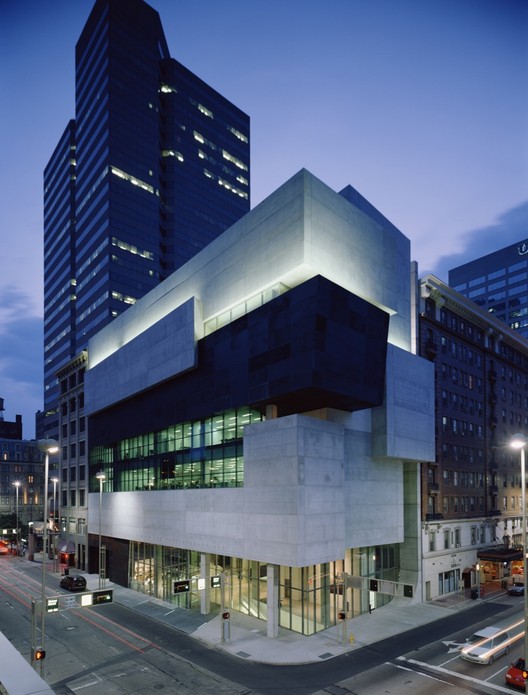
The belief that a building can both blend in and stand out at the same time is embodied by the Lois and Richard Rosenthal Center for Contemporary Art (CAC), located in Cincinnati. Though it's heavy volumetric massing makes it appear as an independent and impenetrable sculptural element, the Rosenthal Center is in fact designed to pull the city in – past its walls and up, toward the sky. This inherent dynamism is well-suited to a gallery which does not hold a permanent collection, and is situated at the heart of a thriving Midwestern city.

The center, founded in 1939, was one of the first institutions of contemporary visual art in the United States.[1] Since the 1960s, the CAC’s galleries were housed in the second floor of a commercial development in downtown Cincinnati. This was exceptional in a time when most contemporary art facilities were situated on the outskirts of the American city; unfortunately, despite its central location, the CAC was virtually invisible from the street. Discussions about a new, dedicated building for the center began in the late 1980s, ultimately leading to a design competition in 1997.[2]


From an initial 97 submissions, the CAC narrowed their choices to 12 semi-finalists, and eventually to three finalists: Daniel Libeskind, Bernard Tschumi, and Zaha Hadid. Each finalist was asked to produce a concept booklet showing not a physical design, but the conceptual approach that they would take. Hadid proposed organizing the museum into a number of independent gallery volumes, all suspended from a warped concrete plane. These functional elements would inform not only the massing of the new museum, but its exterior appearance as well. The proposal was intriguing enough that on March 4, 1998, the CAC formally declared Zaha Hadid victorious.[3]

The site chosen by the CAC was a busy street corner at the heart of downtown Cincinnati. It lay along a pedestrian route running from the nearby Fountain Square to the Aronoff Center for the Arts across the street, ensuring a constant flow of people. It was this pedestrian dynamism that encouraged Hadid to develop the “Urban Carpet,” one of the Rosenthal Center’s two defining design gestures.[4]
The “Urban Carpet” is Hadid’s method of bringing the fabric of the city within the museum’s walls. The ground level lobby is fully glazed and open to public egress, inviting pedestrians to treat the space as an enclosed public square; this serves to situate the Rosenthal Center in the existing network of public spaces and paths, allowing it to operate as a vital urban node and effectively solving the issue of visibility faced by the former gallery facility. The concrete floor of the lobby is connected to the rear wall of the museum by an upward curve, transforming the two into a continuous surface that conceptually draws the urban fabric up from the lobby and into the gallery spaces suspended above.[5]


While the “Urban Carpet” concept informed the design of the ground level, the gallery spaces were driven by another idea: the “Jigsaw Puzzle.” Hadid used the term to illustrate the complex arrangement of differently-sized concrete volumes that house the gallery spaces of the center; the variegated intersections between the volumes and the voids between them could be viewed as a three-dimensional puzzle. The logic behind this massing strategy was simple: as contemporary art can take a variety of forms and sizes, contemporary art galleries must be equally as varied. Therefore, Hadid designed the gallery volumes to vary considerably in length, height, and lighting conditions – an architectural solution for virtually any artistic contingency.[6]

As visually distinct as the “Urban Carpet” and the “Jigsaw Puzzle” are, the circulation connecting the two had to be equally dramatic. The primary means of vertical egress is a series of stair-ramps running back and forth along the rear wall of the museum; the zigzag path of the stairs runs all the way from the ground floor to the uppermost level of the building.[7] Each flight of stairs, wrought of steel and painted black, weighs 15 tons – the maximum weight the cranes used for construction could lift. The entire stair space is lit by skylights on the roof, the light filtering all the way down to the ground level.[8]

Hadid chose not to hide her design strategies within a simplified shell, but to display them openly. The result is two distinct façades, each of which reveals a different aspect of the center’s interior. The south façade, comprising the longer faces of the gallery volumes, expresses the building program through three material choices: glazing, concrete, and black metal panel. The east façade relies not on material, but on massing, with its topography of concrete faces revealing the complex arrangement of gallery volumes within the center.[9]

When the Rosenthal Center for Contemporary Art opened its doors to the public in 2003, it was more than just a new exhibition space for the Contemporary Arts Center. With the center’s opening, Zaha Hadid became the first woman to ever design an American art museum.[10] The Rosenthal Center itself was, and remains, one of the largest and most dynamic contemporary art galleries in the United States – a fitting home for one of the country’s most distinguished institutions in the field.

References
[1] "Lois & Richard Rosenthal Center for Contemporary Art." Zaha Hadid Architects. Accessed May 3, 2016. [access]
[2] Desmarais, Charles. "Contemporary Arts Center, Cincinnati." In Zaha Hadid Space for Art, edited by Markus Dochantschi, 21-31. Baden: Lars Müller Publishers, 2004. p22-23.
[3] Desmarais, p24-26.
[4] Noever, Peter, ed. Zaha Hadid Architektur. Vienna: Hatje Cantz Verlag, 2003. p125-126.
[5] Noever, p126.
[6] Dochantschi, Markus, ed. Zaha Hadid Space for Art. Baden: Lars Müller Publishers, 2004. p46.
[7] Dochantschi, p54.
[8] Jodidio, Philip. Zaha Hadid: Hadid: Complete Works 1979-2009. Köln: Taschen, 2009. p167.
[9] Noever, p127.
[10] Jodidio, p167.
-
Architects: Zaha Hadid Architects
- Area: 8500 m²
- Year: 2003
-
Photographs:Roland Halbe, Paul Warchol
-
Manufacturers: Schöck, High Concrete Group



.jpg?1462559836)
.jpg?1462560115)


.jpg?1462559836)
.jpg?1462560115)




























.jpg?1462560520)

